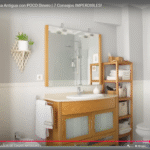In many homes, moisture is a silent threat that eventually ruins walls, paint, siding, and even furniture. If you’ve ever found yourself with stains, cracks, or peeling paint after a heavy rain, you’re not alone. Whether you’re about to build your new home or want to prevent future problems in an existing one, understanding how to properly waterproof exterior walls can save you years of costly repairs.
The good news is that there are practical, affordable, and long-lasting solutions. The key is to act early: dampness must be stopped from the outside, before it penetrates the walls.
What is exterior wall waterproofing and why is it crucial?
Waterproofing an exterior wall means applying layers or treatments that prevent rainwater or ambient humidity from penetrating the wall’s surface and reaching the interior. This protection is vital because water penetrating walls can degrade both the bricks and the bonding materials, causing long-term structural damage and affecting the health of the occupants.
According to construction experts, most moisture problems in homes are due to poorly treated leaks or poorly applied solutions that attempt to “cover up” the problem from the inside.
Main benefits of waterproofing from the outside
- Long-term structural protection
Preventing water from penetrating walls helps preserve the integrity of the materials and prevents cracks or detachment. - Improved interior comfort
Dry walls mean healthier environments, without musty odors or unwanted stains in the interior. - Reducing future repair costs
Investing in good waterproofing from the start prevents unnecessary expenses on repetitive repairs. - Property Revaluation
A well-maintained home, with no visible signs of moisture, has a much higher resale value. - Long-lasting aesthetics
Paints and coatings last longer if they are not constantly exposed to leaks.
Essential steps for waterproofing new walls
If you’re starting from scratch or have bare bones, this is the ideal time to implement an effective system:
- Wall Preparation:
Thoroughly moistening the bricks before applying the first layer is essential. If they are dry, they will absorb the water from the mix and ruin the set. - Application of the water-repellent mortar.
It is a mixture of 1 part cement and 3 parts sand. It is applied directly to the bricks, “stirring” the mixture with a trowel to form a barrier about 5 mm thick. - Immediate coating with coarse plaster.
This layer protects the plaster from drying suddenly and evens out the plumb line of the wall. It should be applied minutes after the previous layer. - Use of a water-repellent additive:
A liquid product that is mixed with the water in the mix to improve waterproofing. Its cost is low and its effectiveness is high. - Finishing with fine plaster or plastic coating
Allows for a more aesthetic surface ready for painting or decorating.
Solutions for exterior walls with existing moisture
What if you’re already suffering the consequences of a leak? Here are some other strategies:
- Evaluate the condition of the plaster
If it is loose, cracked, or sounds hollow when tapped with your knuckle, it is best to remove it completely and redo it following the steps above. - Treat cracks properly
- Dead cracks (small and immobile): can be repaired with exterior filler.
- Live cracks (more than 2 mm or with movement): must be opened and filled with elastic sealant.
- Apply base coat with fiberglass mesh.
This technique reinforces the entire surface, prevents new cracks and leaves the wall ready for painting. - Paint with waterproof latex for exteriors.
Preferably polyurethane-based, as it offers greater elasticity and durability against temperature changes.
Key tips for long-lasting protection
- Don’t waterproof from the inside : you’ll only hide the problem, but you won’t solve it. Moisture will continue to find a way out.
- Check the condition of roofs and eaves : structures that protrude from the roof (eaves) are very effective in protecting walls from direct water.
- Consider cementitious panels : They’re an excellent alternative when there are many cracks and you don’t want to chip away at the entire plaster. They also offer a clean, modern finish.
- Don’t underestimate paint : it’s the first line of defense. A good exterior paint can extend the life of your wall for years.
Transforming a damp wall into a water-resistant surface isn’t just a matter of aesthetics: it’s an investment in health, structural safety, and economic savings. Applying these multiple barriers—such as waterproof plaster, water-repellent additives, waterproof paint, and other reinforcements—creates a system that is robust against the elements.
Don’t wait for leaks to ruin your walls or your budget. Start protecting your home from the outside in today. A good plastering can go unnoticed, but its benefits can be felt every day.



